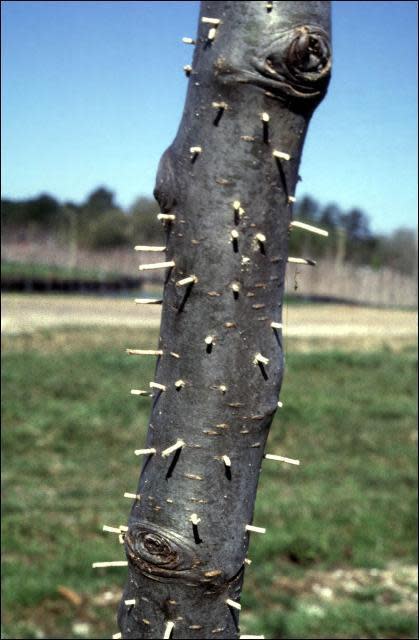Campbell Vaughn: Asian ambrosia beetles are the death of any infested plants

We have a nasty little visitor from Asia that I wish we could build a wall to keep out.
The Asian ambrosia beetle was accidentally imported to the United States in some peach trees in North Carolina that arrived from China in 1974. Since then, this insect has spread all over the U.S. and has caused millions of dollars in plant loss.
I haven’t gotten a call about it yet this spring, but I know it is coming.
These small beetles are tiny blackish brown beetles that resemble southern pine beetles in size and makeup. The female Asian ambrosia beetle emerges in spring from her winter habitat inside an infested tree and travels to a suitable nearby shrub or tree not caring whether the plant is healthy or on the decline. She looks for a small plant or limb and begins to bore into it. She moves fast, eating her way through an inch of wood per day.

As this pesky insect eats her way through the tree, she ejects sawdust out of the entrance hole called frass. The sawdust exiting the hole forms toothpick-like protrusions. This is the key diagnostic feature of Asian ambrosia beetle damage.
Scout for this sawdust in early spring on trees and shrubs. Once the female beetle digs her hole, she deposits her eggs.
The problem with seeing these toothpicks is once they are there the plant is a goner.
The beetles are active year-round, but activity usually starts sometime in March.
You can have several generations per year. Unlike pine beetles that eat the sections of the trees that move water and nutrients up and down the tree, the Asian ambrosia beetle does not feed on the wood. These mothers leave a fungus (ambrosia fungus) to provide a first meal for their larval offspring.
Once the beetle introduces the fungus, the disease damages the xylem tissue which prevents the tree from transporting water and nutrients. The entry holes also create entry points for other disease-causing fungus to attack the plant. Any of these can result in the death of the plant.
A protective spray with bifenthrin or a permethrin insecticide can be sprayed to keep the insects from attacking the plants in early spring and repeated every six to eight weeks. But once the plant is attacked, there is nothing you can do but administer last rites and put it on the funeral pyre. Seriously, infested plants should be removed from the property and burned or chipped.
Campbell Vaughn: Latest crop of Vidalia onions are now on sale. Learn why they are so special.
On another note, in one of my recent columns I mentioned seeing cedar waxwings eating on some berries right before the Masters. The day I turned my column on the waxwings, I got home and went outside to enjoy the beautiful day.
On the edge of the neighbor’s property is a large glossy privet/ligustrum. I don’t like the plant because it is highly invasive and is a prolific seeder. That privet was literally sagging with a gazillion black berries to the point to where I thought the branches were going to break. And the waxwings cometh. They obviously took a liking to this glossy privet because they started picking the berries off one by one. One day later there were zero berries on that plant. I am sure they will be glad to pass them to your yard on the way to their next big feast.
This article originally appeared on Augusta Chronicle: No plant can survive the Asian ambrosia beetles

